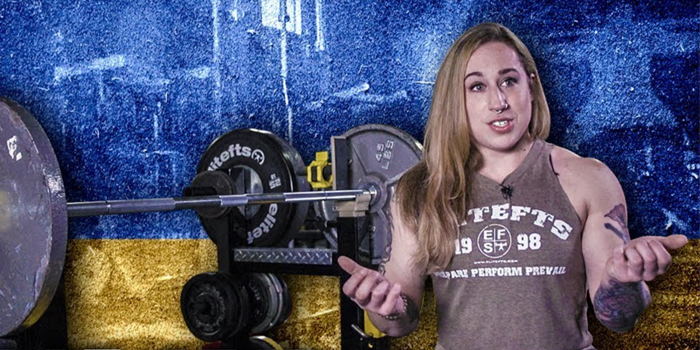
elitefts Project Manager Janis Finkelman is here to break down the Reverse Grip Bench Press. As someone who holds the No. 8 all-time total in sleeves (1,052 pounds in the 132 weight class) and previously held two all-time world record deadlifts (454-pound deadlift at 123 and 496 pounds at 132), she’s a dang good person to learn from!
The Reverse Grip Bench Press is a bench press, but one that requires a supinated, or palm-facing upward, grip.
For this lift, Janis recommends using a bar with aggressive knurling because keeping your grip during reverse grip work is really important.
Next up is the setup. Where you set up with this bench is going to be different than a regular bench press or some other bench press variant. In order to perform this lift, Janis has to position herself further up the bench — usually a solid two to three inches further back than she normally would be.
Then, you’ll depress your shoulders like your typical bench.
"People ask, 'OK, where should I put my hands on the bar?' I’ve experimented with this. When I started with it, I was a little narrower than I tend to like to go now, and in general, people do advocate taking a wider grip on the bar. This is going to be very, very dependent on individual leverages, mobility within the wrist, elbow. You’re going to want to play around with it, but as a rule, I would say you want to try to set up so your grip might be slightly wider than your normal competition-style bench grip. Definitely experiment."
You’ll also need patience with this lift. Lots and lots of patience.
And you’ll also want to be careful about setting the bar nice and deep into the heel of your hand. Think of your hand as a flat bed for the bar to rest on. Don’t get sloppy with your grip when you unrack.
"If I screw up at all with reverse grip, everything’s going to go to hell really fast."
To prevent that from happening, Janis locks her shoulder blades in and keeps a really tight grip on the bar. As she unracks the bar and lowers it, she says you might feel like you’re touching lower than you would in a normal bench press.
Also, don’t be afraid to put chalk on your hands for reinforcement. There’s no shame in that, and it will help.
Janis also tries to focus on control during lockout. She aims to have as little excess motion as possible when the bar is going through lockout.
She also notes that a reason a lot of people use the Reverse Grip Bench Press is due to shoulder issues. That’s actually why Janis started doing it: it doesn’t aggravate her shoulder issues, and it has carryover to the typical competition-style lift — and Janis’ numbers support this claim.
"This isn’t the saving grace thing for everybody who has a shoulder issue. I have had people say, 'I have shoulder issues. I tried Reverse Grip, and it made it really flare up.' So it’s going to be an individual thing. If you have a shoulder issue, this might not be OK for you, so you can try something else. But for a lot of people, with this movement, it’s going to be a good way to avoid certain issues that the bench really kind of makes problematic with shoulder use."









